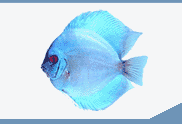

 |
||||||||||||
 |
||||||||||||
| Blackworm culture (Lumbriculus variegatus) for use as a live fish food for the Hobbyist | ||||||
| Page 2 of 2 | Back to Page 1 | |||||
Some sources for Blackworms
Supplimental information Okay, here's the deal. I would set at least one of your cultures up with the brown paper towels or shopping bags. Use one layer with an inch of water (if you are using an airstione you can use several inches of water). This is your backup culture, as it's a proven method. Though more difficult to get the worms from. The burlap culture I am trying is only about a month old, but is doing very well. I have a single layer of burlap in a 10 gallon tank. Spread the burlap out flat. I am aerating it with a 6 inch air stone, but any airstone should work. Initially don't feed anything for about a week, remember there will be biological filtration isssues here just as with a tank. Worms also create waste -- I haven't tried it but I toyed with using mulm as a food source as it would also give the culture nitro bacteria. After a few days to a week, you can feed a small pinch of flake -- I use a meat lover's flake mixed in the water. I do this weekly, and if I see it hasn't been eaten in a few days I change the water. You'll lose some worms with the dead worms and debris when you pour it off. You can minimize this by filling the tub with water, stirring, and letting settle a minute. The live worms generally sink, then pour off. At no time should the culture smell foul. If it does then there is too much food, not enough air, or bad bacteria is a problem. Some have said they use an antibiotic in their tubiflex culture -- I haven't used any but it may save a culture if there's a probelm. The key to the getting any of these cultures started is to use healthy starter material. When you get your blackworms they'll be on ice probably. Rinse them in ice cold water until the water is clear. Now put them in a tub, with just barely enough water to cover them and let them come to room temperature. Once they do you'll see them actively moving about. Now wait an hour or so, checking them periodically. You'll notice the really healthy ones clump up. Also you'll notice that they'll actually try to climb out of the containers at the corners. It looks like a sci-fi movie. These are your healthiest worms and are good for culture. Watch out for leeches, and worms that are clear (dead). Cultures take time to establish. Only use a handful of healthy worms to get the culture started; too many and you'll foul the water. Their numbers will grow naturally as the burlap breaks down. Oxygen is key here, as well as monitoring it carefully in the beginning. If you can keep several cultures going, and try different parameters, experiment on the water depth and density of worms, and amount of aeration. Supplimental information, part 2 Just an update: both the paper method and the burlap method work, but you need to really aerate it and change water a lot. I have not been able to get huge amounts of worms though. For a hobbyist wit a couple of fish, no problem. For a discus addict, Aquatic Foods is still a necessity. Sorry. That said, I have a culture going with nothing in the tank but air and some fish food and they are doing very good. |
 |
|||||
| About Us :: Message Board :: Chat | |||||
| Library :: Photo Gallery :: Links & Resources :: Breeders & Sponsors :: Merchandise | |||||
| Website designed by: EthanCote.com | © 2001-2004, SimplyDiscus.com. All Rights Reserved. | ||||